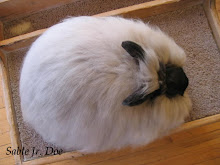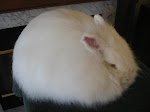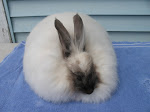--Another post from the old blog:
After lots of reading and lots of time spent wracking my brain about what a good conditioning regimen might be for an Angora rabbit, (AARGH!!) I have finally come up with something to try with my rabbits that may provide a slightly increased holding time and an enhanced condition during the Prime period.
The problem with figuring out how to condition an Angora vs. any other short haired breed seems to be that A) the composition of the coat is very different from that of a short haired rabbit, and B) the growth and molting schedule is also different and often more frequent. Some people feel that Angora is susceptible to 'wool breaks' just like sheep wool is when the nutritive content of the feed is changed dramatically, and others believe that Consistency is the key overall and the same supplement/ration level should be used year round regardless of wool, growth, or molt cycle. Most short-haired rabbit breeders change feed schedules abruptly depending on coat phase and season, but since a sudden change can have an adverse effect on Angora wool, whatever gets added or taken away from the diet must be added and withdrawn slowly, and the feed schedule that is in place must be followed consistently so that negative effects on the coat can be minimized.
What I did to work out a usable formula for angoras was to read different accounts of conditioning programs used by short haired and angora breeders alike, and I talked to a few experienced breeders of both in order to get their opinions. What all articles and people said in common were the things that I tried to include in my own formula, and here is the diet I came up with that I am going to institute with my own herd:
1) Up until the age of 6 months give plain pellets only, with Oats mixed in or fed separately each day. Do not overfeed pellets----make sure that your babies always have plenty to eat but try to make sure that they clean their dishes out completely before giving them more (overfeeding at this age can prevent them from developing good skeletal structure and muscle before the conditioning process begins)
2) After the main growing period is over (6-9 months for an FA, depending on line and genetics), begin supplementing pelleted ration with a grain mix containing barley, oats, milk pellets, horse sweet feed, black oil sunflower seed, OR roasted soynuts, birdseed, barley, oats, OR any other combination of grains that you have found to work with your rabbits. Offer the Mix in the morning and Pellets at night or vice versa, and try to spread feeding the two approx. 12 hours apart. It is important to reduce your pellet level to accomodate this supplement, so if you feed 1/4 cup grain mix, you need to reduce your pellets to 3/4 cup later on.
3) Feed normal Pellet plus Supplement ration until RIGHT before the rabbit hits Prime (in many angoras this will work out to be about the third month of growth), and then slowly reduce the pellets about 1/4 cup, feed plenty of hay, and ADD MORE OATS to the grain mix so that the energy level goes down and you can shift the coats from 'growth' to 'maintenance' mode.
4) Keep the ration amount lowered to about 3/4 cup total until your coats slip and molt. Afterward, begin the whole process over again once the coat has been harvested and you are sure that the molt is completely finished. In addition to this, remember to adjust your feed program according to the season and individual needs. In hot weather be sure to scale back grain mix and feed somewhat, but in cold weather remember to add more to maintain coat and flesh condition. Also, disregard all of the above when feeding pregnant and nursing does, and also realize that you will occasionally have rabbits who will just eat more or less according to their own constitutions, and prepare to treat them accordingly no matter what the 'norm' may be.
I realize this formula is not much different than most of the other ones out there, but the main difference when feeding an angora is simply that changes need to be made gradually to accomodate the needs of a unique coat. I will give this regimen a try for a year or so through approx. 2 growth cycles in my own breeding program, and if it works I will jump around and celebrate, LOL, but if it doesn't I will scrape together the pieces and look for something else that does.
Til next time.....:)
Sunday, February 22, 2009
Subscribe to:
Post Comments (Atom)























No comments:
Post a Comment